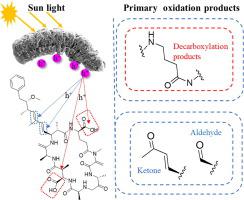Chemical Engineering Journal ( IF 13.3 ) Pub Date : 2020-10-28 , DOI: 10.1016/j.cej.2020.127543 Yarui Wang , Fengjie Chen , Wanchao Yu , Lixia Zhao

|
Fates of toxic foundational groups of Microcystin-LR in aqueous have garnered widespread attention because of the difficulty of removal during photocatalytic process. Here, an efficient N, P co-doped TiO2/expanded graphite (NPTEG) floating material (NPTEG) modified by poly dimethyl diallyl ammonium chloride (PDDA) and graphitic carbon nitride (g-C3N4) (x PDDA-g-C3N4-NPTEG) was assembled and used to destroy the toxic foundational groups of MC-LR in water. g-C3N4 can match well with TiO2 to form heterojunction where holes can gather in the valence band of g-C3N4. PDDA is used to passivate the g-C3N4, and performs as holes transport layer during the photocatalytic process to promote the separation of electron-hole pairs. Under the direct interaction of photo-generated holes and free carboxyl groups of MC-LR adsorbed on the surface, the decarboxylation process in the free acid groups on D-glutamic acid (Glu) and methyl-D-aspartic acid (D-MeAsp) of MC-LR occurred which was authenticated by UPLC-ESI-MS/MS. Meanwhile, the conjugated double bond was also removed by hydroxylation, so as to achieve the goal of non-toxic site residues in the degradation process. Furthermore, the degradation byproducts toxicity and photocatalysts stability were explored. The results confirm that x PDDA-g-C3N4-NPTEG exhibits excellent attacking ability of carboxylic acid groups of MC-LR and high recycle ability, which has great promise as a means of effectively treating drinking water.
中文翻译:

通过孔直接氧化使微囊藻毒素-LR的D-Glu和D-MeAsp脱羧的有效浮动吸附光催化剂
微囊藻毒素-LR在水中的毒性基础基团的命运因其在光催化过程中的去除困难而受到广泛关注。在这里,一种高效的N,P共掺杂的TiO 2 /膨胀的石墨(NPTEG)漂浮材料(NPTEG)由聚二甲基二烯丙基氯化铵(PDDA)和石墨氮化碳(gC 3 N 4)(x PDDA-gC 3 N组装(4- NPTEG)并用于破坏水中MC-LR的有毒基础基团。gC 3 N 4可以与TiO 2很好地匹配,形成异质结,空穴可以聚集在gC 3 N 4的价带中。PDDA用于钝化gC 3 N 4,并在光催化过程中充当空穴传输层以促进电子-空穴对的分离。在光生空穴和吸附在表面的MC-LR的游离羧基的直接相互作用下,D-谷氨酸(Glu)和甲基-D-天冬氨酸(D-MeAsp)上的游离酸基的脱羧过程发生了由UPLC-ESI-MS / MS验证的MC-LR错误。同时,通过羟基化也去除了共轭双键,从而达到降解过程中无毒部位残留的目的。此外,还研究了降解副产物的毒性和光催化剂的稳定性。结果证实,x PDDA-gC 3 N 4-NPTEG表现出优异的MC-LR羧酸基团攻击能力和高循环能力,作为有效处理饮用水的手段具有广阔的前景。











































 京公网安备 11010802027423号
京公网安备 11010802027423号